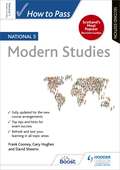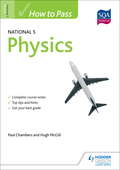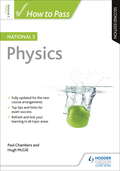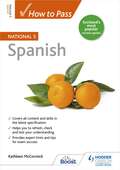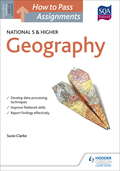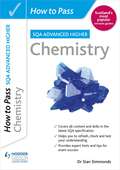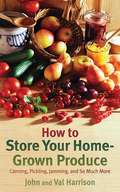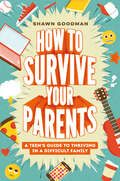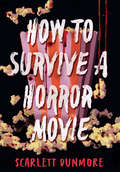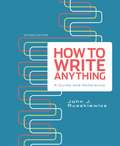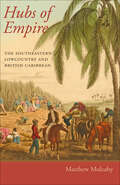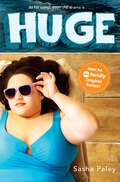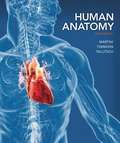- Table View
- List View
How to Pass National 5 Modern Studies: Second Edition Ebook
by Gary Hughes Frank Cooney David SheerinExam Board: SQALevel: National 5Subject: Modern StudiesFirst Teaching: August 2017First Exam: May 2018Fully updated to account for the removal of Unit Assessments and the changes to the National 5 exam, this book contains all the advice and support you need to revise successfully. It combines an overview of the course syllabus with advice from top experts on how to improve exam performance, so you have the best chance of success.- Refresh your knowledge with complete course notes- Prepare for the exam with top tips and hints on revision technique- Get your best grade with advice on how to gain those vital extra marks
How to Pass National 5 Physics
by Paul Chambers Hugh McGillGet your best grade with the SQA endorsed guide to National 5 Physics.This book contains all the advice and support you need to revise successfully for your National 5 exam. It combines an overview of the course syllabus with advice from a top expert on how to improve exam performance, so you have the best chance of success. Refresh your knowledge with complete course notes Prepare for the exam with top tips and hints on revision technique Get your best grade with advice on how to gain those vital extra marks
How to Pass National 5 Physics: Second Edition Ebook
by Paul Chambers Hugh McGillExam Board: SQALevel: National 5Subject: PhysicsFirst Teaching: August 2017First Exam: May 2018Fully updated to account for the removal of Unit Assessments and the changes to the National 5 exam, this book contains all the advice and support you need to revise successfully. It combines an overview of the course syllabus with advice from top experts on how to improve exam performance, so you have the best chance of success.- Refresh your knowledge with complete course notes- Prepare for the exam with top tips and hints on revision technique- Get your best grade with advice on how to gain those vital extra marks
How to Pass National 5 Spanish
by Kathleen McCormickTrust Scotland's most popular revision guides to deliver the results you want. The How to Pass series is chosen by students, parents and teachers again and again.This is the only study guide that is structured around the skills of reading, writing, listening and talking, to align closely with the assessments.> Practise, practise, practise. Develop the four key skills as you answer questions across the specified contexts of society, learning, employability and culture.> Read, listen, succeed. All-new text extracts and audio files give you plenty of opportunities to build your understanding of the Spanish language so you can aim for a better grade.> Improve your vocabulary and grammar. 'What you should know' summaries, a vocabulary checklist and a grammar guidance chapter help you to master the basics. > Get expert tips for all assessments. From quick, handy hints to detailed, step-by-step advice on the exam, assignment and performance, this book has everything you need to feel confident and prepared.
How to Pass National 5 and Higher Assignments: Geography
by Susan ClarkeThe perfect guide to the Assignment component at National 5 and Higher.Assignment work at National 5 contributes to 25% of your final grade, and to 33% at Higher. This How to Pass Assignments at National 5 and Higher Geography title offers complete guidance on making your Assignment content and presentation appropriate, including:advice on selecting appropriate topicsresearching this topic at home and in the fieldre-format findings into processed information, before writing them up
How to Pass SQA Advanced Higher Biology
by Graham Moffat Billy DicksonExam board: SQALevel: Advanced HigherSubject: BiologyFirst teaching: August 2019First exam: Summer 2021Trust Scotland's most popular revision guides to deliver the results you want. The How to Pass series is chosen by students, parents and teachers again and again.This is the only study book that addresses the skills for Advanced Higher Biology, as well as the knowledge.> Recap and remember course content. Concise summaries and diagrams cover the important points for each Key Area in the latest SQA specification.> Test your skills and knowledge. Regular 'check-up' questions throughout the text help you to see if a topic is secure before you move on. This style of active revision is much more effective than simply reading.> Practise exam-style questions. Formal questions with mark allocations are provided at the end of each Key Area, reflecting the types of questions you will face in the exam. Three course assessments are also included.> Get expert tips for exam success. Hints on how to achieve top marks and avoid mistakes are based on feedback in the SQA examiners' Course Reports, giving you insight into the marking process.> Teach yourself with confidence. Independent study has never been easier with clear explanations, definitions of technical terms and answers to all questions at the back of the book.> Plan and manage your revision. Checklists for each Key Area enable you to benchmark your progress against SQA's assessment standards and make sure you're on track to get the grades you need.
How to Pass SQA Advanced Higher Chemistry
by Sian SimmondsExam board: SQALevel: Advanced HigherSubject: ChemistryFirst teaching: August 2019First exam: Summer 2021Trust Scotland's most popular revision guides to deliver the results you want. The How to Pass series is chosen by students, parents and teachers again and again.This is the only study book that addresses the skills for Advanced Higher Chemistry, as well as the knowledge.> Recap and remember course content. Concise summaries and diagrams cover the important points for each Key Area in the latest SQA specification.> Test your skills and knowledge. Regular 'check-up' questions throughout the text help you to see if a topic is secure before you move on. This style of active revision is much more effective than simply reading.> Practise exam-style questions. Formal questions with mark allocations are provided at the end of each Key Area, reflecting the types of questions you will face in the exam.> Get expert tips for exam success. Hints on how to achieve top marks and avoid mistakes are based on feedback in the SQA examiners' Course Reports, giving you insight into the marking process.> Teach yourself with confidence. Independent study has never been easier with clear explanations, definitions of technical terms and answers to all questions at the back of the book.> Plan and manage your revision. Checklists for each Key Area enable you to benchmark your progress against SQA's assessment standards and make sure you're on track to get the grades you need.
How to Pass SQA Advanced Higher Physics
by Paul Chambers Mark RamsayExam board: SQALevel: Advanced HigherSubject: PhysicsFirst teaching: August 2019First exam: Summer 2021Trust Scotland's most popular revision guides to deliver the results you want. The How to Pass series is chosen by students, parents and teachers again and again.This is the only study book that addresses the skills for Advanced Higher Physics, as well as the knowledge.> Recap and remember course content. Concise summaries and diagrams cover the important points for each Key Area in the latest SQA specification.> Test your skills and knowledge. Regular 'check-up' questions throughout the text help you to see if a topic is secure before you move on. This style of active revision is much more effective than simply reading.> Practise exam-style questions. Formal questions with mark allocations are provided at the end of each Key Area, reflecting the types of questions you will face in the exam.> Get expert tips for exam success. Hints on how to achieve top marks and avoid mistakes are based on feedback in the SQA examiners' Course Reports, giving you insight into the marking process.> Teach yourself with confidence. Independent study has never been easier with clear explanations, definitions of technical terms and answers to all questions at the back of the book.> Plan and manage your revision. Checklists for each Key Area enable you to benchmark your progress against SQA's assessment standards and make sure you're on track to get the grades you need.
How to Prove It: A Structured Approach (Second Edition)
by Daniel J. VellemanThis book helps students to develop deductive reasoning ability in general and to learn the underlying principles involved in the construction of proofs by focusing on "structured proving."
How to Stop Freaking Out: The Ultimate Guide to Keeping Cool When Life Feels Chaotic
by Carla NaumburgFrom the bestselling author of How to Stop Losing Your Sh*t With Your Kids comes the ultimate guide for middle grade readers about managing stress and anxiety when life gets chaotic. Within these pages, readers will learn what a freak out is (and isn&’t), discover why people flip out when they&’re stressed, practice keeping cool in the most chaotic moments, and choose one of many strategies for calming down when things are totally overwhelming. Along the way, there are: • Quizzes! What&’s your freak out style? • Truth Bombs! You don&’t have to be perfect. • Freak Out Facts! There are more nerve cells in your body than there are stars in the Milky Way. THE MOST IMPORTANT THING TO REMEMBER: You can—and will—have big, intense, unpleasant feelings. The trick is knowing how to manage them. Uniquely designed to meet readers ages 8 and up, this book is filled with techniques, tools and most importantly, understanding, to guide readers through all the twists and turns on the roller coaster called LIFE.
How to Store Your Home Grown Produce
by John Harrison Val HarrisonIt's wonderful to grow your own fruit and vegetables but what do you do when it all ripens at once? How do you cope with the glut which threatens to overwhelm you?Will help all those who grow their own fruit and vegetables to store their produce properly so that it will last for months and feed the family when the garden's bare.Easy and practical advice on how to bottle, dry, freeze and even salt home grown fruit and vegetables.Discover the taste of your delicious homemade jams, chutneys and ketchups.John and Val Harrison reveal just what you can do with that bountiful harvest and share their 30 years' experience of growing fruit and vegetables and you'll never waste another tomato or courgette again.Praise for John Harrison:'Britain's greatest allotment authority'. Indpendent on Sunday.
How to Store Your Home-Grown Produce: Canning, Pickling, Jamming, and So Much More
by John Harrison Val HarrisonDid your tomato plant produce twice as many tomatoes as you'd planned? Grow too much cabbage? Harvest too many blueberries? If so, here is practical advice on how to bottle, dry, freeze, and even salt home-grown fruits and vegetables. Discover extra storage space in your home or learn how to convert a shed or garage to store your tasty products. Learn how to make chutneys from fruit; pickles from cucumbers; and ciders, jams, and even ketchup from your garden! There is even advice here on drying foods, with instructions on how to store them in oil as well as ways to freeze and blanch your fruits and vegetables.
How to Succeed in Academics
by Linda L. Mccabe Edward R. B. MccabeLinda L. McCabe and Edward R. B. McCabe, both professors at the University of California, Los Angeles, write clearly and accessibly, illustrating their main points with sample case scenarios.
How to Survive Your Parents: A Teen's Guide to Thriving in a Difficult Family
by Shawn GoodmanWant to improve your relationship with your problematic parents? This honest and supportive guide, written by an experienced teen therapist, will help.This book is for you―not your parents. Step-by-step, using approaches that are relatively easy but bring big results, you&’ll be guided in how to improve the important and super-challenging relationship between you and your parents. This doesn&’t mean you&’re going to become best friends, but you will learn the skills needed to change how you see one another and how you interact. And ultimately, you will gain control over your own life.Included are revealing descriptions of various problematic parenting styles, techniques—both verbal and not—for increasing the connection between you and your parents, advice about setting clear boundaries, and sample conversations that can be used as a script. Think of it as therapy in book form: on your side, encouraging and clear, and full of the time-proven advice you won&’t get from your friends and certainly not from your parents.
How to Survive a Horror Movie
by Scarlett DunmoreHorror movie buff Charley Ryan isn&’t expecting much when she&’s enrolled at a girls&’ boarding school on a remote island. That is, until someone starts killing off the senior class. From elaborate scare tactics to severed heads in fridges, these gruesome murders are straight out of Charley&’s favorite films. To top it off, she&’s also seeing the ghosts of her former classmates. No one&’s surprised when Charley&’s taste in movies makes her the prime suspect. Determined to clear her name, she sets out to find the killer before her campus becomes more graveyard than school. She&’s equipped only with her encyclopedic knowledge of horror cinema and the help of her trusty cinephile best friend, Olive—oh, and those pesky ghosts, if they can shut up long enough to lend a helping hand. With a plot twist sure to make you SCREAM, this is an addictive love letter of a slasher that will keep you guessing until the very last page.
How to Write Anything: A Guide and Reference (Second Edition)
by John J. RuszkiewiczDesigned to be clear and simple, How to Write Anything combines the thoughtfulness of rhetorics with the efficiency of brief handbooks. Through memorable visuals and honest talk, John Ruszkiewicz shows students how to write in any situation -- wherever they are in their writing process. With everything you need to teach composition, the Guide lays out focused advice for writing common genres, while the Reference covers the range of writing and research skills that students need as they work across genres and disciplines. An intuitive, visual cross-referencing system and a modular chapter organization that' s simple to follow make it even easier for students to work back and forth between chapters and stay focused on their own writing.
How to Write a BA Thesis: A Practical Guide from Your First Ideas to Your Finished Paper
by Charles LipsonThe senior thesis is the capstone of a college education, but writing one can be a daunting prospect. Students need to choose their own topic and select the right adviser. Then they need to work steadily for several months as they research, write, and manage a major independent project. Now there's a mentor to help. How to Write a BA Thesis is a practical, friendly guide written by Charles Lipson, an experienced professor who has guided hundreds of students through the thesis-writing process. This book offers step-by-step advice on how to turn a vague idea into a clearly defined proposal, then a draft paper, and, ultimately, a polished thesis. Lipson also tackles issues beyond the classroom-from good work habits to coping with personal problems that interfere with research and writing. Filled with examples and easy-to-use highlighted tips, the book also includes handy time schedules that show when to begin various tasks and how much time to spend on each. Convenient checklists remind students which steps need special attention, and a detailed appendix, filled with examples, shows how to use the three main citation systems in the humanities and social sciences: MLA, APA, and Chicago. How to Write a BA Thesis will help students work more comfortably and effectively-on their own and with their advisers. Its clear guidelines and sensible advice make it the perfect text for thesis workshops. Students and their advisers will refer again and again to this invaluable resource. From choosing a topic to preparing the final paper, How to Write a BA Thesis helps students turn a daunting prospect into a remarkable achievement.
How to Write a Children's Picture Book and Get it Published, 2nd Edition
by Andrea ShavickThis book provides comprehensive advice on what to write about for children, how to write it, and how to present the work professionally for publication. It includes an easy-to-use picture book layout plan and tried and tested examples of title sheets and covering letters. It also includes everything a writer needs to know about the international picture book market and how to sell to agents and publishers.This new edition contains advice on enhancing your text for the ebook market.
How to be a Global Citizen: Be Informed. Get Involved.
by DKBe the change in your community! This illustrated guide takes you through challenges the world is facing and how you and your kids can help overcome them. Aspiring activists and young community leaders need information and tools to be responsible citizens and changemakers in their communities. This activism book is packed with content that will both educate and challenge young children aged 11+ years to make a difference.How to be a Global Citizen covers topics such as politics and voting, how to be responsible with online communication, preventing unfair discrimination, and protecting our environment. You&’ll find: • Creative illustrations and clear text simplify challenging topics • Advice for parents and teachers on explaining tricky social and environmental issues to children • Steps to contribute to society at an individual level • Features on inspirational young role models leading the charge on different causes around the world Inspire youth with tales of their peersYoung people are leading movements around the world, influencing their communities, and illuminating issues that have plagued our societies for far too long. Each chapter of How to be a Global Citizen provides information and ideas on how children can have important conversations amongst friends, family, and the wider community to affect change. Children are inspired by the stories of young leaders such as LGBTQ+ rights activist, Jazz Jennings, and environmentalist, Greta Thunberg. And each of their stories serves to be an example of what it means to be a responsible citizen, how to make the world a better place, and how to care for our societies and environment. Other titles to Help Your Kids DK&’s Help Your Kids series is aimed at young readers ages 11 + years, parents, and teachers. These books are an excellent resource to help children understand complex topics. Other books in this series include Help Your Kids with English, Help Your Kids with Study Skills, and Help Your Kids with Dyslexia.
How to code in Python: GCSE, iGCSE, National 4/5 and Higher
by Greg ReidEnsure every student can become fluent in Python with this highly practical guide that will help them understand the theory and logic behind coding.Written for 14-16-year olds by a leading Python specialist and teacher, and aligned to curriculum requirements, this essential Student Book provides numerous practice questions and coding problems that can be completed as homework or during class - plus answers can be found online at www.hoddereducation.co.uk/pythonextrasHow to Code in Python will:> Provide hundreds of coding examples, puzzles and problem-solving tasks to strengthen computational thinking skills required for GCSE, iGCSE and National 4 / 5 success> Help students become proficient in computational thinking and problem-solving using Python> Provide easy-to-follow explanations of concepts and terminology> Feature plenty of opportunities for self-assessment with solutions to coding problems available onlineThis unique book can be broken down into three key features:> Code theory and explanations (worked examples) in a fun and accessible way> Computational thinking puzzles for the reader to solve; this will greatly improve students' ability to read code and predict its effect and output when run> Programming problems where the reader has to write a program to solve given scenariosGreg Reid is a very experienced Computer Science teacher in Scotland, who has written How to Pass Higher Computer Science and Higher Computing Science Practice Papers for Hodder Gibson.
Hubs of Empire: The Southeastern Lowcountry and British Caribbean (Regional Perspectives on Early America)
by Matthew MulcahyAn introduction to the rich history and culture of the Greater Caribbean—the wealthiest region in British America.In Hubs of Empire, Matthew Mulcahy argues that it is useful to view Barbados, Jamaica, and the British Leeward Islands, along with the South Carolina and Georgia Lowcountry, as a single region. Separated by thousands of miles of ocean but united by shared history and economic interest, these territories formed the Greater Caribbean. Although the Greater Caribbean does not loom large in the historical imaginations of many Americans, it was the wealthy center of Britain’s Atlantic economy. Large-scale plantation slavery first emerged in Barbados, then spread throughout the sugar islands and the southeastern mainland colonies, allowing planters to acquire fortunes and influence unmatched elsewhere—including the tobacco colonies of Maryland and Virginia.Hubs of Empire begins in the sixteenth century by providing readers with a broad overview of Native American life in the region and early pirate and privateer incursions. Mulcahy examines the development of settler colonies during the seventeenth and early eighteenth centuries, explores diverse groups of European colonists, and surveys political, economic, and military issues in the decades before the Seven Years War. The plantation system achieved its fullest and harshest manifestation in the Greater Caribbean. The number of slaves and the scale of the slave trade meant that enslaved Africans outnumbered Europeans in all of the affiliated colonies, often by enormous ratios. This enabled Africans to maintain more of their traditions, practices, and languages than in other parts of British America, resulting in distinct, creole cultures. This volume is an ideal introduction to the complex and fascinating history of colonies too often neglected in standard textbook accounts.
Huge
by Sasha PaleyApril and Wil couldn't be more different, but both of them are spending the summer at Wellness Canyon -- otherwise known as a weight-loss camp. April knows that if she could just drop a little weight, she would be popular like she's always wanted. She's saved up for months to afford Wellness Canyon, which is more like a posh spa than a sleepaway camp. While April can't wait to jump into all the activities, Wil can't wait to get out of there. Her parents own a chain of high-profile fitness centers, and she's pretty sure her mom and dad sent her to Wellness Canyon to slim down before any embarrassing stories about their obese daughter hit the gossip pages. To get revenge on her parents, Wil decides she's going to gain weight at Wellness Canyon. It's bad enough that they have to share a room, but things really get ugly when April and Wil both fall for Colin, the sarcastic camp hottie. Are April and Wil destined to be frenemies all summer, or can they overcome their sizeable differences? Filled with everything great about summer camp (and none of the calories), this is a funny, emotional novel about learning to accept yourself -- no matter what your size.
Human Anatomy
by Frederic H. Martini Michael J. Timmons Robert B. TallitschThe Eighth Edition includes new one- and two-page Spotlight Figures that seamlessly integrate text and visuals to guide students through complex topics. This program presents a better teaching and learning experience.
Human Anatomy and Physiology (4th edition)
by Elaine N. MariebIn this text Marieb (Holyoke Community College) integrates the relationships of body organ systems, homeostasis, and complementarity of structure and function.
Human Anatomy and Physiology (7th Edition)
by Katja Hoehn Elaine Nicpon MariebWith each edition of her top-selling "Human Anatomy & Physiology" text, Elaine N. Marieb draws on her own, unique experience as a full-time A&P professor and part-time nursing student to explain concepts and processes in a meaningful and memorable way. With the "Seventh Edition," Dr. Marieb has teamed up with co-author Katja Hoehn to produce the most exciting edition yet, with beautifully-enhanced muscle illustrations, updated coverage of factual material and topic boxes, new coverage of high-interest topics such as Botox, designer drugs, and cancer treatment, and a comprehensive instructor and student media package. The Human Body: An Orientation, Chemistry Comes Alive, Cells: The Living Units, Tissue: The Living Fabric, The Integumentary System, Bones and Skeletal Tissues, The Skeleton, Joints, Muscles and Muscle Tissue, The Muscular System, Fundamentals of the Nervous System and Nervous Tissue, The Central Nervous System, The Peripheral Nervous System and Reflex Activity, The Autonomic Nervous System, The Special Senses, The Endocrine System, Blood, The Cardiovascular System: The Heart, The Cardiovascular System: Blood Vessels, The Lymphatic System, The Immune System: Innate and Adaptive Body Defensives, The Respiratory System, The Digestive System, Nutrition, Metabolism, and Body Temperature Regulation, The Urinary System, Fluid, Electrolyte, and Acid-Base Balance, The Reproductive System, Pregnancy and Human Development, Heredity For all readers interested in human anatomy & physiology.
